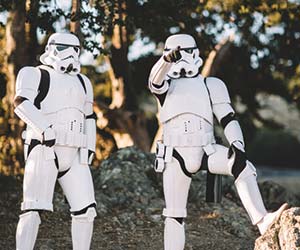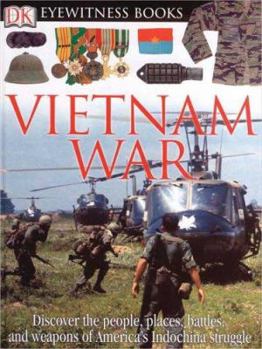DK Eyewitness Books: Vietnam War: Discover the People, Places, Battles, and Weapons of America's Indochina Struggl
(Part of the DK Eyewitness Books Series and DK Eyewitness Books Series)
Select Format
Select Condition 
Book Overview
A visual and informative guide to one of the longest and most controversial wars in American history, now revised and updated in the relaunched DK Eyewitness Books format.Explore the people, places,... This description may be from another edition of this product.
Format:Hardcover
Language:English
ISBN:0756611660
ISBN13:9780756611668
Release Date:May 2005
Publisher:DK Publishing (Dorling Kindersley)
Length:72 Pages
Weight:1.28 lbs.
Dimensions:0.4" x 8.8" x 11.1"
Age Range:8 to 12 years
Grade Range:Grades 3 to 7
Customer Reviews
5 ratings
Military Book
Published by Thriftbooks.com User , 15 years ago
Very pleased with my order and the way it was shipped. Thank you, John
Errata
Published by Thriftbooks.com User , 17 years ago
These books are fun and recommended. The following are a list of corrections to some of the captions: 1. Page 28 This is not an SKS (the fellow on page 46 is holding an SKS). This appears to be a Mosin Nagant 1891/44 missing its folding bayonet. 2. Page 30 Of course, the boots were designed to be anything BUT waterproof. Waterproof means nothing in water up to your waist. They were designed to dry quickly (2 large grommets on the instep to drain water are not seen here). Canvas was used among other reasons because (as the Japanese discovered) it rots less quickly than leather in the jungle. 3. Page 35 The ominous looking projection on the front of the Huey is in fact an FM antenna. Having a cannon projecting through the pilot would have been inconvenient.
Eyewitness Books Vietnam War
Published by Thriftbooks.com User , 17 years ago
Excellent book in keeping with the high standard of other Eyewitness Books. Lots of pictures and information on the time period.
The people, places, battles, and weapons of America's Indochina struggle
Published by Thriftbooks.com User , 18 years ago
By the time I got my draft card the Vietnam War was just about over; besides I am deaf in one ear so they were never going to take me and making any sort of decision was a moot point. Today what I find interesting that is although I basically lived through the Vietnam War, I do not have the same sense of what happened during the war that has defined all American military action ever since that I do for the Civil War or World War II. For that matter, I think I have a better understanding of the chronology of the American Revolution and Desert Storm than I do of the war in Vietnam. Fortunately, this Eyewitness Books volume devoted to the "Vietnam War" helps me move a bit beyond the sketchy understanding I had when I open the book (basically, something that happened in the Gulf of Tonkin was used as an excuse to escalate American military involvement, the corrupt government of South Vietnam fell, the Tet offensive surprised everybody, Nixon bombed enemy troops in Cambodia, there was a massacre at My Lai, and we left by helicopters). Of course, Stuart Murray goes back a bit further, beginning with the War in French Indochina that led to the independence movement for Vietnamese independence led by Ho Chi Minh. The French defeat at Dien Bien Phu and the Geneva Accords set the group for American advisors begin sent after the end of the First Indochina War. Once we get to the Gulf of Tonkin Incident, the Vietnam War begins in earnest. Murray sets up the two sides in terms of their allies, leaders, and capital cities. Operation Rolling Thunder began the bombing of North Vietnam, while the Ho Chi Minh Trail was the network of wilderness routes used to by the North to get troops and supplies to the South. The chronology of the war continues throughout the book interspersed with looks at specific elements of fighting the war. The struggle for the Central Highlands, battles in the Mekong Delta, and the war on inland waters are detailed. The massacre at My Lai is covered in the look at villages in wartime, followed by the siege of Khe Sanh and the Tet Offensive, Hamburger Hill is part of the beginning of the U.S. withdrawal, and the last air assaults, including the Christmas bombing before the Paris Peace Accords. Finally, we get to the fall of Saigon and the Aftermath both there and here. In between the history of the war there are chapters devoted to Napalm and Agent Orange as key part of chemical warfare, a look at the weapons of war on both sides, what it was like to go on patrol and be ambushed by the VC, and what medical care meant on both sides is covered as well. Other chapters are devoted to Heliborne warfare, warplanes in combat, the tunnels used by the Viet Cong, and the story of Prisoners of war. What the war was like at home is also covered, with chapters on "The Television War," and the antiwar movement. There is additional information provided in the back of the book. The "Did you know?" section devotes a page to Fascinating Fac
Helping our children understand the Vietnam War
Published by Thriftbooks.com User , 19 years ago
Growing up in the 60s and 70s, I was very aware of the Vietnam War. I was not old enough to be a warrior or a peace activitst. However, I watched and read a lot about the war. Even at a young age, I knew enough to get information from different points of view. In the first decade of the new century, few children and teenagers have much understanding of the lessons of the Vietnam War. This is a serious lack. To be informed citizens, we need to understand our own history. But how do you explain such a complex war to a 10 year old? I gave this book to my 10 year old son in anticipation of a trip to Vietnam. He enjoyed it and was able to be quite articulate in discussing a number of things about the war. DK does a good job of making history relevant by using a visual presentation. It would have been much more difficult to get a child or young adolescent to read a print-only book about a "parents' generation" war. Each page has several color photographs and then uses these to explain the history of the war. This particular book makes an effort to be even handed by presenting information about the American troops, the protesters, and the various Vietnamese factions. It shows the weapons used by both sides. There is a discussion of Agent Orange and Napalm. The medical sections shows how both the Americans and the Vietcomg treated their wounded. The section on "The Television War" helps explain how television shaped the American reaction to the war. At the end of the book there is a helpful glossary of terms. There is also a "Find Out More" section that lists useful websites and has a list of museums and memorials to visit in the US. I would recommend supplementing the book by encouraging the child or adolescent to talk to adults who served in Vietnam, or protested the war. Following these discussions, one might ask the child to consider the similarities and differences to the current war in Iraq.
Vietnam War Mentions in Our Blog

It's Star Wars Day in Galaxies Far, Far Away and Very, Very Close
Published by Beth Clark • May 04, 2018
To celebrate, we've gathered a few Star Wars reads, facts, fiction, fun, and more favorites for Rebel and Imperial fans of all ages.






